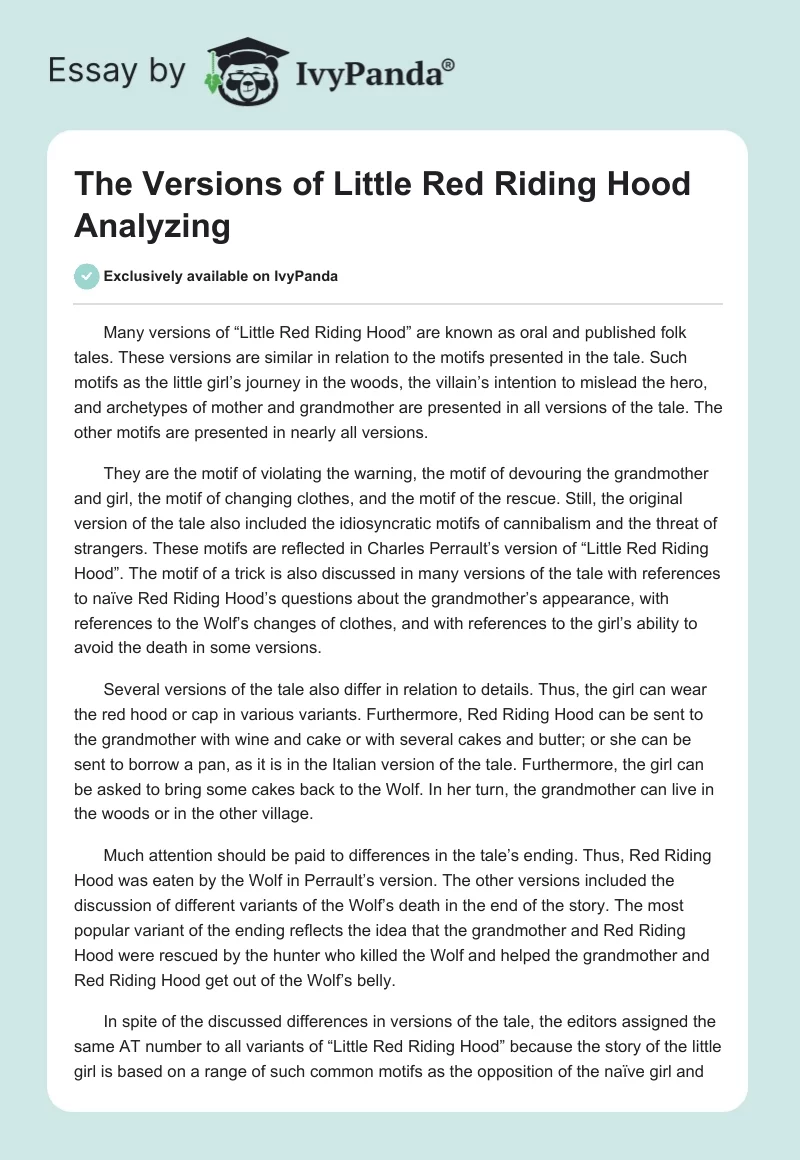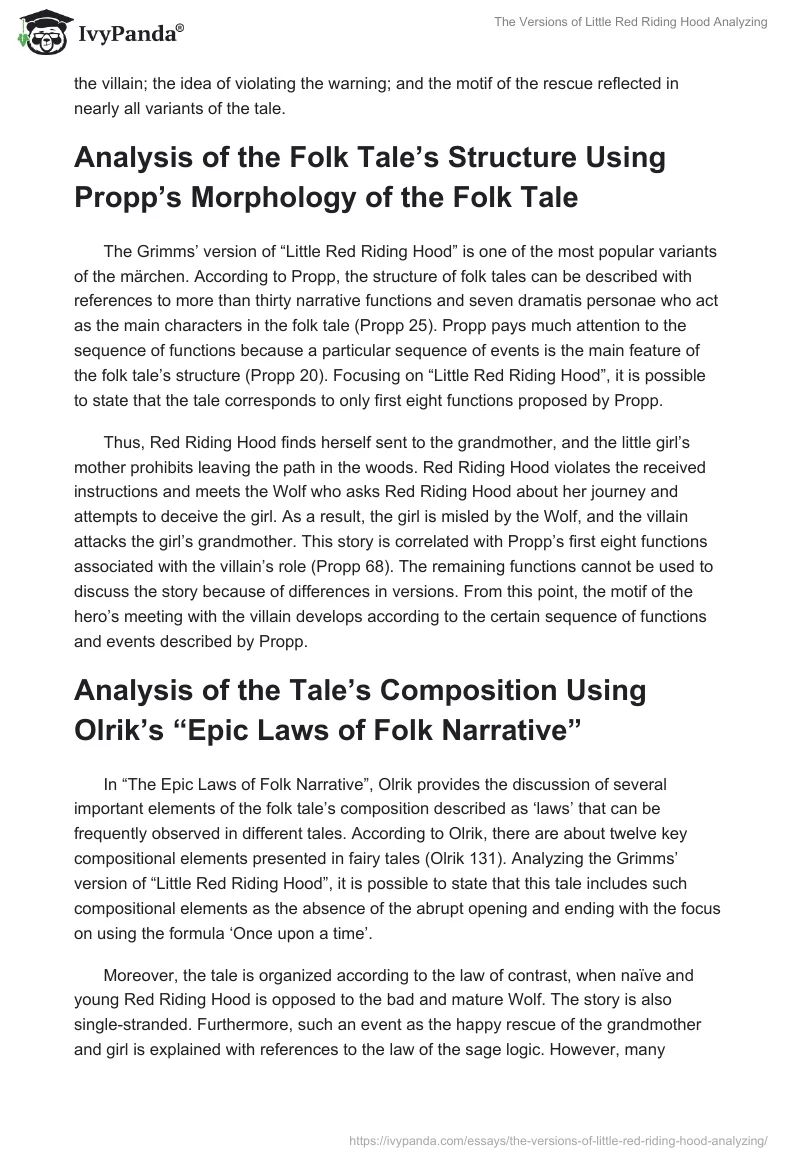Many versions of “Little Red Riding Hood” are known as oral and published folk tales. These versions are similar in relation to the motifs presented in the tale. Such motifs as the little girl’s journey in the woods, the villain’s intention to mislead the hero, and archetypes of mother and grandmother are presented in all versions of the tale. The other motifs are presented in nearly all versions.
They are the motif of violating the warning, the motif of devouring the grandmother and girl, the motif of changing clothes, and the motif of the rescue. Still, the original version of the tale also included the idiosyncratic motifs of cannibalism and the threat of strangers. These motifs are reflected in Charles Perrault’s version of “Little Red Riding Hood”. The motif of a trick is also discussed in many versions of the tale with references to naïve Red Riding Hood’s questions about the grandmother’s appearance, with references to the Wolf’s changes of clothes, and with references to the girl’s ability to avoid the death in some versions.
Several versions of the tale also differ in relation to details. Thus, the girl can wear the red hood or cap in various variants. Furthermore, Red Riding Hood can be sent to the grandmother with wine and cake or with several cakes and butter; or she can be sent to borrow a pan, as it is in the Italian version of the tale. Furthermore, the girl can be asked to bring some cakes back to the Wolf. In her turn, the grandmother can live in the woods or in the other village.
Much attention should be paid to differences in the tale’s ending. Thus, Red Riding Hood was eaten by the Wolf in Perrault’s version. The other versions included the discussion of different variants of the Wolf’s death in the end of the story. The most popular variant of the ending reflects the idea that the grandmother and Red Riding Hood were rescued by the hunter who killed the Wolf and helped the grandmother and Red Riding Hood get out of the Wolf’s belly.
In spite of the discussed differences in versions of the tale, the editors assigned the same AT number to all variants of “Little Red Riding Hood” because the story of the little girl is based on a range of such common motifs as the opposition of the naïve girl and the villain; the idea of violating the warning; and the motif of the rescue reflected in nearly all variants of the tale.
Analysis of the Folk Tale’s Structure Using Propp’s Morphology of the Folk Tale
The Grimms’ version of “Little Red Riding Hood” is one of the most popular variants of the märchen. According to Propp, the structure of folk tales can be described with references to more than thirty narrative functions and seven dramatis personae who act as the main characters in the folk tale (Propp 25). Propp pays much attention to the sequence of functions because a particular sequence of events is the main feature of the folk tale’s structure (Propp 20). Focusing on “Little Red Riding Hood”, it is possible to state that the tale corresponds to only first eight functions proposed by Propp.
Thus, Red Riding Hood finds herself sent to the grandmother, and the little girl’s mother prohibits leaving the path in the woods. Red Riding Hood violates the received instructions and meets the Wolf who asks Red Riding Hood about her journey and attempts to deceive the girl. As a result, the girl is misled by the Wolf, and the villain attacks the girl’s grandmother. This story is correlated with Propp’s first eight functions associated with the villain’s role (Propp 68). The remaining functions cannot be used to discuss the story because of differences in versions. From this point, the motif of the hero’s meeting with the villain develops according to the certain sequence of functions and events described by Propp.
Analysis of the Tale’s Composition Using Olrik’s “Epic Laws of Folk Narrative”
In “The Epic Laws of Folk Narrative”, Olrik provides the discussion of several important elements of the folk tale’s composition described as ‘laws’ that can be frequently observed in different tales. According to Olrik, there are about twelve key compositional elements presented in fairy tales (Olrik 131). Analyzing the Grimms’ version of “Little Red Riding Hood”, it is possible to state that this tale includes such compositional elements as the absence of the abrupt opening and ending with the focus on using the formula ‘Once upon a time’.
Moreover, the tale is organized according to the law of contrast, when naïve and young Red Riding Hood is opposed to the bad and mature Wolf. The story is also single-stranded. Furthermore, such an event as the happy rescue of the grandmother and girl is explained with references to the law of the sage logic. However, many compositional elements are addressed in “Little Red Riding Hood” only partially, or they are not addressed at all.
Analysis of the Theme according to Holbek’s “The Language of Fairy Tales”
In his work “The Language of Fairy Tales”, Holbek introduces a complex system in order to explain transformations and symbolic changes occurred in relation to folk tales’ characters. It is possible to determine three oppositions developed by Holbek in order to discuss themes in folk tales. These oppositions reflect the differences in gender, maturity, and status (Holbek 44). Holbek refers to these oppositions presented in the folk tales as a kind of crises important for the characters. In addition, Holbek chooses to use the thematic axes in order to describe how these oppositions are interrelated in fairy tales (Holbek 46).
While discussing the evolution of the characters in “Little Red Riding Hood”, it is important to concentrate on the evolution of the Wolf because he changes the male and female identities in order to mislead the little naive girl. Furthermore, it is also important to state that Red Riding Hood also experiences the process of evolution related to her maturation during the journey. From this perspective, the tale demonstrates Red Riding Hood’s evolution from one stratus to another. Still, this evolution associated with the changes in the young and adult category cannot be observed in all the versions of the folk tale.
Summary of the Findings
The versions of “Little Red Riding Hood” can be discussed as similar if the listener or reader of the story does not pay attention to details and descriptions of the environments because the main motifs of the opposition between the naïve girl and the villain, the motif of violating the warning, and the motif of the rescue are reflected in nearly all versions of the tale. Furthermore, it is possible to focus on the appearance of the same characters or dramatis personae discussed by Propp in all versions of the story. Such characters as the hero and the villain as well as the archetype of the mother are represented in all variants of the fairy tale. These motifs and archetypes help perceive rather different versions as the same story because of the obvious repetition of the same ideas.
Nevertheless, the versions are characterized by a lot of differences. These differences are associated with the events following the meeting of the little girl and the Wolf, and they are related to the variants of the tale’s ending. Discussing the versions of “Little Red Riding Hood”, it is important to focus on the controversial motif of cannibalism reflected in some variants of the tale. Description of the girl drinking the blood and eating the flesh of the grandmother is presented only in the first variants of the story.
Later, these details were changed, and the motif was reflected only in the fact that the Wolf ate the girl and grandmother. Absence or presence of certain motifs in different versions should be explained with references to the influence of specific cultural contexts. Cultural particularities are also addressed with references to what cap the girl is wearing, what nickname she has, why she is sent to the grandmother, and what products she is told to bring to the grandmother.
The structural and formal analyses can be discussed as effective to be used for the versions of “Little Red Riding Hood” in spite of the fact that the tale addresses only first eight points of Propp’s structure. However, this sequence of events is presented in the tale’s versions directly and without significant changes.
Moreover, the tale seems to be organized according to the basic epic laws, and there are no violations of the structural of compositional principles in the discussed folk tales. Still, various versions of the folk tale also provide different paths for the transformation of the Wolf and maturation of the little girl. From this point, different tellers focus on various ideas to accentuate them in the version of the popular European folk tale, but they focus on the same structure of the tale.
Analyzing the versions of “Little Red Riding Hood”, I found the discussion of such motifs as cannibalism and the threat of strangers interesting because these motifs are fully discussed only in the first variants of the tale, and the later interpretations have only hints on the previous variants. Still, the analysis of the version with references to Holbek’s ideas was rather tedious because the evolution of Red Riding Hood is not clearly observed in the tale, and it is possible to refer only to hints in different versions of the story.
There were no pointless activities or lacking points associated with the analysis of the tale, but I was rather unprepared for finding many interpretations of the same motifs while changing the approach to analyzing the tale. In addition, I need to explore more information on the earliest and latest versions of the tale in order to discuss all changes in the sequence of events, accentuated motifs, and details.
Works Cited
Holbek, Bengt. “The Language of Fairy Tales”. Nordic Folklore: Recent Studies. Ed. Reimund Kvideland and Henning Sehmsdorf. Bloomington, IN: Indiana University Press, 1989. 40-62. Print.
Olrik, Axel. “The Epic Laws of Folk Narrative”. The Study of Folklore. Ed. Alan Dundes. Englewood, NJ: Prentice Hall College, 1965. 129-141. Print.
Propp, Vladimir. Morphology of the Folktale. Austin: University of Texas Press, 1968. Print.


